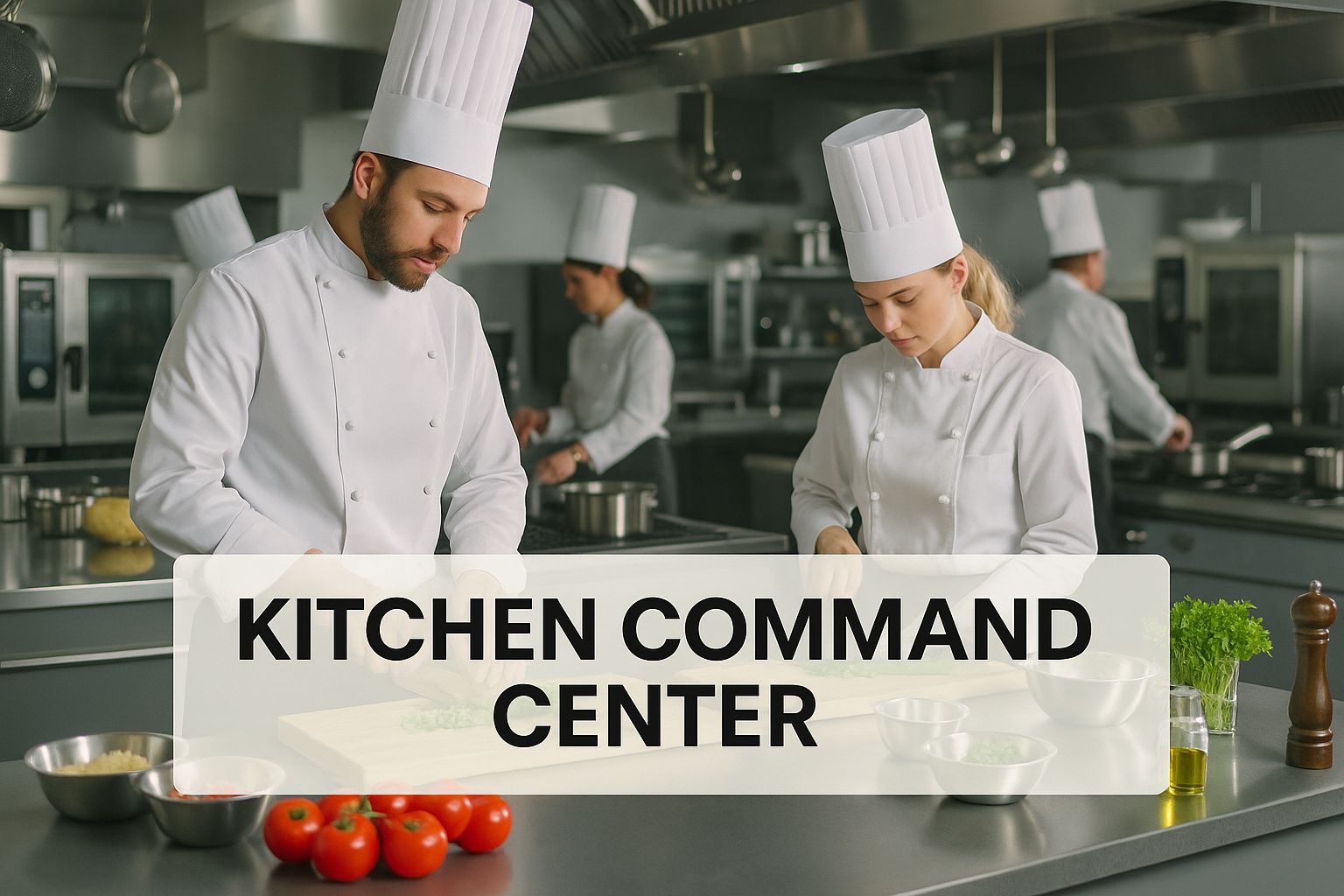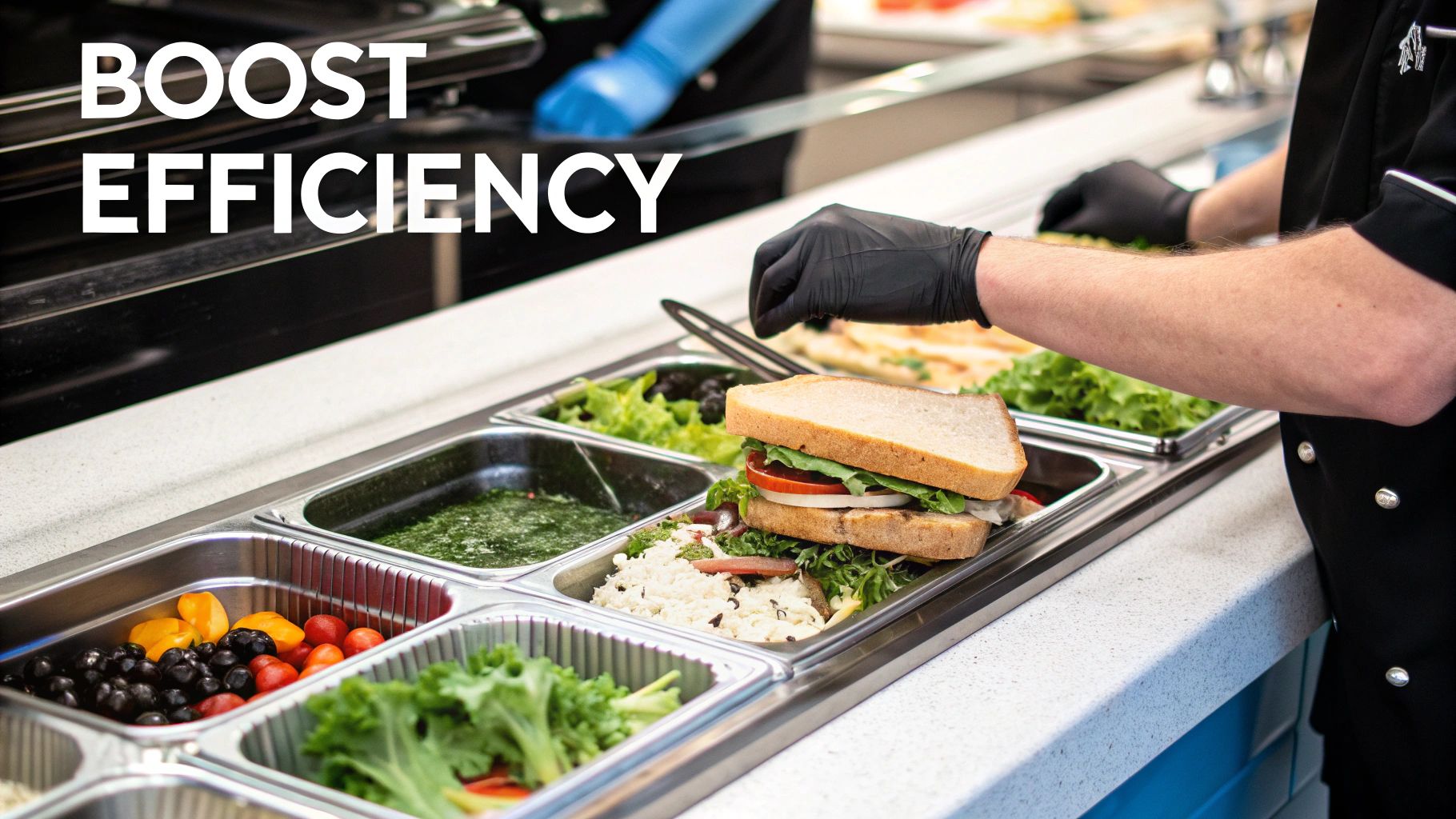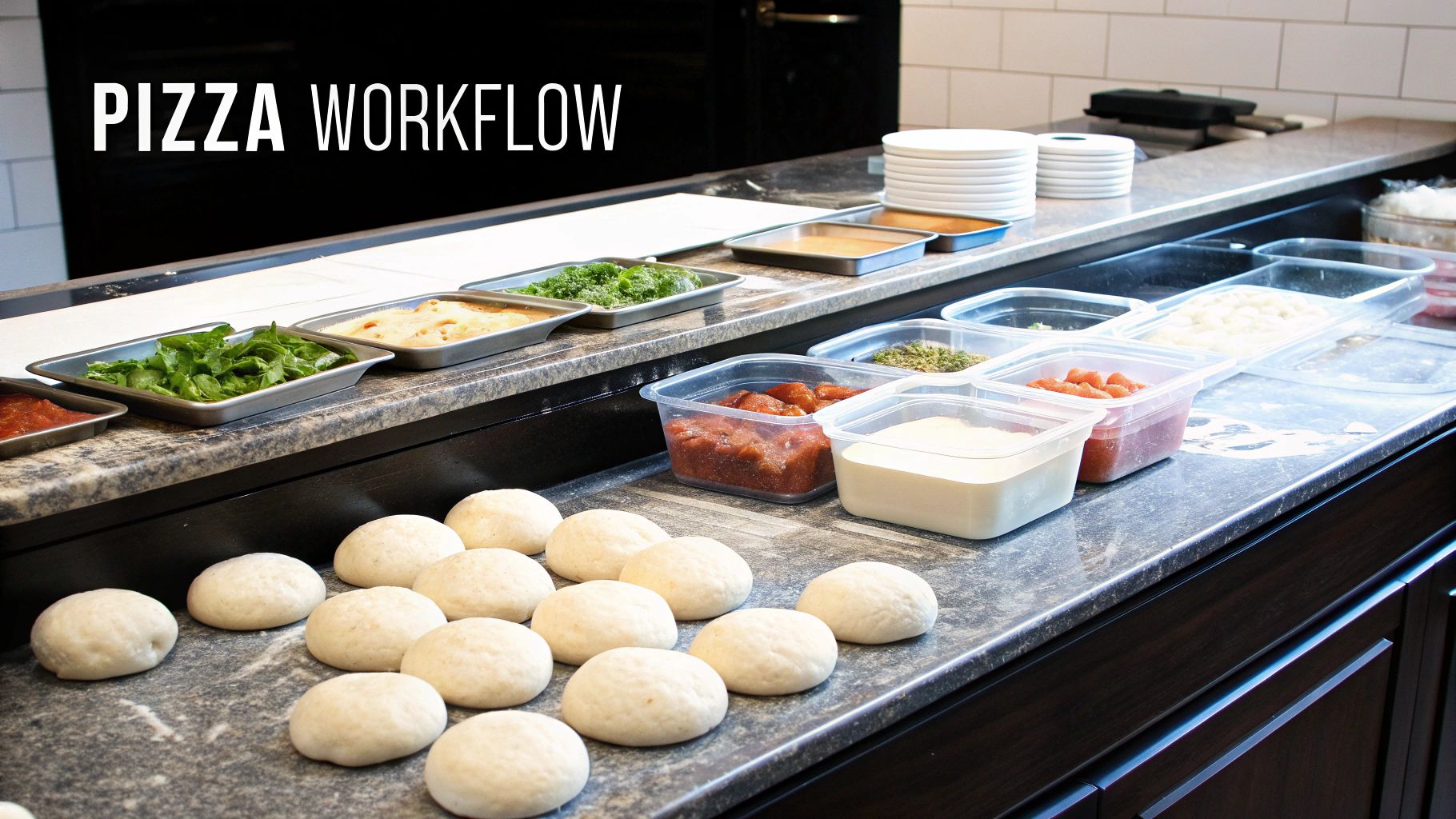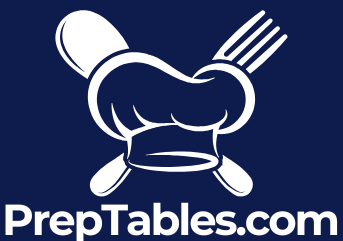
A Complete Guide to Restaurant Prep Tables
Share
A restaurant prep table isn't just a piece of furniture; it's the operational heart of any commercial kitchen. This is the dedicated space where every meal begins its journey, from raw ingredients to finished plate. Think of it as a direct investment in your kitchen's workflow, one that has a massive impact on speed, safety, and organization.
The Foundation of an Efficient Commercial Kitchen
Picture your kitchen's workflow like a river. A well-chosen restaurant prep table is like a series of perfectly placed channels, guiding the flow of ingredients and tasks smoothly from one point to the next. The wrong table, on the other hand, is a dam, creating frustrating bottlenecks and grinding service to a halt.
This guide is about more than just product descriptions. We’re going to dig into how different prep tables—from basic stainless steel workhorses to specialized refrigerated units—directly shape your day-to-day operations. Getting a handle on these differences is the first real step toward building a more efficient and productive kitchen.
The Kitchen's Command Center
The right prep surface is so much more than a place to chop vegetables; it's a strategic tool. A smart table arrangement dictates how your team moves, cuts down on wasted steps, and keeps everyone in sync during the dinner rush.
The infographic below really brings this idea to life, showing the prep table as the central 'Kitchen Command Center' in a busy culinary environment.

As you can see, the prep table centralizes every critical activity, from the first chop to the final plating. It’s a non-negotiable asset for a smooth-running kitchen.
Impact on Kitchen Workflow
Picking the right equipment is one of the most fundamental things you can do for your business. When your prep station is optimized, the benefits are felt throughout the entire service.
- Increased Speed: An organized prep area with everything within arm's reach lets chefs build dishes faster. That means lower ticket times and happier customers.
- Enhanced Safety: A proper table setup is your first line of defense against cross-contamination and helps ensure ingredients are always held at safe temperatures.
- Improved Organization: Having designated zones for different tasks keeps the kitchen from descending into chaos, even during a high-volume Saturday night.
Selecting the perfect restaurant prep table is a direct investment in your kitchen’s productivity. It's a foundational piece of equipment that, when chosen correctly, can dramatically reduce prep time and improve service quality.
Of course, the table is just one piece of the puzzle. Looking at broader strategies on how to improve overall restaurant operations can take your kitchen's efficiency to the next level. By pairing the right tools with smart processes, you create a system built for success.
Now, let's break down the different types of tables out there so you can find one that fits your menu and workflow like a glove.
The Main Types of Restaurant Prep Tables
Choosing the right restaurant prep table can feel overwhelming. You have standard workhorses, highly specialized refrigerated units, and everything in between. The key is to match the table's design to your menu's specific demands. Let's explore the most common types available for commercial kitchens, from versatile stainless steel surfaces to task-specific models like sandwich and pizza prep tables.
The All-Purpose Workhorse: Standard Stainless Steel Prep Tables
The standard stainless steel work table is the foundation of nearly every commercial kitchen, prized for its durability, ease of sanitation, and versatility. It's the go-to surface for a huge range of tasks, from butchering meat and chopping vegetables to plating finished dishes. But not all stainless steel tables are created equal. Key features differentiate a basic surface from a truly functional workstation:
- Tables with Backsplashes: A backsplash is a raised lip along the back of the table. This simple feature is crucial for preventing food and liquids from splashing onto walls or falling into the hard-to-clean gap between the table and the wall.
- Tables with Undershelves: An undershelf provides invaluable storage space for bulk ingredients, small appliances, or cookware, keeping items off the floor and maximizing the use of your kitchen's vertical space.
- Edge Variations: Tables come with different edge types. A squared edge is common, but a marine edge (raised on all sides) is excellent for containing spills during messy tasks like trimming meat.
- Material and Gauge: As we'll discuss later, the grade (like 304 vs. 430) and gauge (thickness) of the steel determine the table's durability and resistance to corrosion, making them critical factors in your decision.
The Specialists: Refrigerated Prep Tables
Moving beyond the all-purpose table, we enter the realm of specialized, refrigerated prep tables. These units are designed for high-volume, assembly-line-style production of items like sandwiches, salads, and pizzas. By integrating cold storage directly into the workstation, they create an incredibly efficient environment that keeps perishable ingredients fresh, safe, and within immediate reach.
This fusion of a durable prep surface with built-in refrigeration eliminates the need for chefs to constantly walk to and from the main cooler, dramatically cutting down on ticket times and improving overall kitchen workflow.
Sandwich and Salad Prep Tables
For delis, cafes, and restaurants where custom-built sandwiches and salads are a core menu item, these tables are indispensable. Their defining feature is the refrigerated top rail, a series of chilled pans (or "wells") that hold all necessary ingredients—from sliced meats and cheeses to fresh vegetables and dressings. This setup, combined with a cutting board work surface and a refrigerated cabinet or drawer base below, creates a self-contained station where staff can assemble orders with maximum speed and efficiency.

Pizza Prep Tables
Pizzerias have a unique workflow, and pizza prep tables are engineered to meet those specific needs. They typically feature an extra-deep work surface to provide ample room for stretching large pizza doughs. The refrigerated ingredient rail is often raised and angled towards the chef for better ergonomics and easier access to a wide array of toppings. Many models offer work surfaces made of marble or granite, which stay naturally cool to prevent dough from becoming warm and sticky. The refrigerated base is configured to perfectly hold dough proofing boxes, ensuring a consistent supply is always ready.

Selecting the Right Stainless Steel for Durability
When you’re shopping for a restaurant prep table, the term "stainless steel" feels simple enough, but there’s a lot going on under the surface. It's not just one material. It’s a whole family of alloys, and the one you pick will have a huge say in how long your table lasts, how it looks, and how it stands up to the daily chaos of a professional kitchen.
Getting this right is the difference between a table that’s a workhorse for years and one that starts looking old and beaten up way too soon. Think of it like buying tires for a truck—you wouldn't put city tires on a rig meant for rough, off-road terrain. A busy kitchen is its own kind of rough terrain, full of moisture, acidic foods, and constant scrubbing, so your choice of steel really matters.
The Two Titans of Steel 304 vs 430
In the world of kitchen equipment, the steel debate usually comes down to two main players: 304 and 430 grade. They might look the same to the naked eye, but their guts are completely different, and that changes everything about how they perform.
-
304 Grade Stainless Steel: This is the heavyweight champion, the absolute go-to for any surface that will touch food. What makes it so tough? Nickel. This alloy gives it incredible resistance to rust and corrosion. It can handle everything from acidic tomato sauces to harsh cleaning chemicals without breaking a sweat.
-
430 Grade Stainless Steel: This one is the more budget-friendly option, mostly because it skips the nickel. It's still a solid, durable material, but its corrosion resistance isn't quite on the same level, making it a poor choice for the main worktop. A fun fact: it's magnetic, which is a dead giveaway you're not looking at 304 grade.
A good rule of thumb is this: if food or liquids will be on it, you need 304 grade steel. For parts that see less action, like the table legs or an undershelf, the more affordable 430 grade is a smart, practical choice. This way, you get toughness where you need it and save money where you can.
Understanding Steel Gauge
After you've picked your grade, the next number to know is the gauge. This is just a way of measuring the steel's thickness. It can feel a bit backward at first: the lower the gauge number, the thicker and beefier the steel is. A lower gauge means a stronger table that won’t buckle under heavy mixers or complain about aggressive chopping.
- 14-Gauge: This is the tank. It’s the thickest, toughest option you can get, built for serious work like butchering or holding up heavy-duty equipment.
- 16-Gauge: This is the crowd-pleaser. It strikes a great balance between serious strength and a reasonable price, making it perfect for most everyday prep tasks.
- 18-Gauge: This is the lightest-duty option. It’s more economical and works well for storage, light prep, or in spots that don’t see a ton of abuse.
The demand for solid kitchen gear is only going up. The global market for food prep tables was valued at USD 1.18 billion in 2023 and is expected to hit USD 1.62 billion by 2029, which just shows how much kitchens are prioritizing equipment that lasts.
Making the Right Investment
Picking the right material isn't just about the upfront cost; it's an investment in your kitchen's future. A table built with the right grade and gauge of steel will pay for itself over and over again through sheer reliability.
If you really want to get into the weeds of material science and what makes certain metals last, the Titan Edge Titanium blog is a great resource from a company that lives and breathes this stuff.
At the end of the day, getting the steel right ensures your prep table will be a hygienic, dependable foundation for your kitchen for a long, long time. For a deeper dive, check out our guide on the different types of restaurant stainless steel tables.
How Sandwich and Salad Prep Tables Boost Efficiency
If your restaurant is built on fresh, made-to-order sandwiches, vibrant salads, or custom bowls, a specialized prep table isn't just another piece of equipment—it's the engine of your entire operation. These units are designed with one goal in mind: turning a clunky, multi-step process into a smooth, lightning-fast workflow. They are the secret to crushing a high-volume lunch rush without ever compromising on quality or speed.
Unlike a plain old stainless steel surface, these restaurant prep tables pull every necessary tool and ingredient into a single, compact station. This smart design cuts down on wasted steps, reduces the chance of errors, and keeps the production line humming.
The Refrigerated Rail: The Heart of the Operation
The absolute game-changer for a sandwich and salad prep table is its integrated refrigerated rail. This is the row of chilled pans or wells sitting at the top of the unit, right where the chef needs them. Think of it as a perfectly organized, cold pantry just inches from your cutting board.
This rail keeps every single ingredient—from sliced tomatoes and crisp lettuce to cheeses and sauces—at a consistently safe temperature. It completely eliminates those constant trips to the walk-in cooler, a huge workflow killer that can add precious minutes to every ticket. By keeping everything within arm's reach, chefs can build orders with an efficient, assembly-line rhythm.
This immediate access doesn't just slash service times; it's also a massive win for food safety. Ingredients stay well out of the temperature "danger zone" (40°F to 140°F), which is absolutely critical for passing health inspections and preventing foodborne illness.
Choosing Your Base: Cabinets vs. Drawers
Underneath the main work surface, these tables come with different refrigerated storage options, usually either cabinets or drawers. The right choice really comes down to what you're storing and how your team works.
-
Cabinet Bases: These offer big, open spaces that are perfect for stashing bulk items like bags of lettuce, large tubs of dressing, or backup food pans. They’re incredibly versatile and can handle items of all shapes and sizes.
-
Drawer Bases: Drawers give you a much more organized system for smaller, pre-portioned ingredients. They're ideal for keeping different meats, cheeses, or toppings neatly separated and easy to grab, which helps prevent cross-contamination and makes inventory checks a breeze.
The combination of an integrated cutting board, a refrigerated top rail, and an accessible cold base creates a self-contained workstation. This setup allows one or two staff members to handle a high volume of orders without ever leaving their station, maximizing labor efficiency.
The market certainly reflects how vital these units are. The global sandwich and salad prep table market was valued at USD 1.2 billion and is expected to climb to USD 1.71 billion by 2032. This growth is being driven by restaurants and quick-service spots modernizing their kitchens to keep pace with customer demand. You can explore more about this trend in this detailed market analysis.
At the end of the day, a dedicated sandwich prep table transforms what your kitchen is capable of, letting you serve fresh, high-quality food at the speed your customers demand. For a deeper dive into specific models, check out our guide on choosing the perfect sandwich prep table.
Designing Your Workflow with Pizza Prep Tables
Making the perfect pizza isn't about some secret magic trick. It's all about creating a smooth, repeatable workflow, and a dedicated pizza prep table is the heart of that system. These tables are engineered from the ground up to support every single step, from slapping down the first dough ball to adding that last pinch of mozzarella. For any serious pizzeria chasing consistency and speed, they're non-negotiable.
Think of it this way: a standard prep table is just a flat surface. A pizza prep table, on the other hand, is a complete, self-contained workstation. Its features are designed to solve the unique challenges of making pizza, turning what could be a chaotic mess into a clean, efficient assembly line.
The Cool Advantage of the Work Surface
The first thing you’ll probably notice about a proper pizza prep table is the work surface itself. Many aren't just stainless steel; they often feature stunning slabs of marble or granite. This isn’t just for show—it’s a massive functional advantage. These natural stones stay inherently cool, which is exactly what you need when you're working with dough all day.
A cool surface keeps pizza dough from getting sticky and overworked. When dough warms up, it gets frustratingly tough to handle and can bake into a dense, chewy crust. By keeping that dough at the right temperature, these surfaces let your crew stretch bases faster and more consistently, building a perfect foundation every time.
Built for the Pizza-Making Process
Beyond the cool-to-the-touch surface, the entire design is laser-focused on pizza production. There are a few key things that make these tables totally different from other restaurant prep tables.
- Extra-Deep Surface: Pizza prep tables are built with a deeper workspace, usually around 32 inches, a big step up from the standard 24 or 30 inches. That extra real estate is a game-changer for handling large pizza skins without bumping into the ingredient rail.
- Raised Refrigerated Rail: The refrigerated rail holding your topping pans is raised up and angled toward the chef. This simple, ergonomic tweak makes it so much easier to see and grab every ingredient, which dramatically speeds up the topping process.
- Refrigerated Base: The cabinet underneath is designed with a pizzeria's needs in mind. It's perfectly configured to hold stacks of dough-proofing boxes at the ideal temperature, so you always have fresh dough ready to go.
By combining a cool work surface, an accessible topping rail, and dedicated dough storage, a pizza prep table creates a complete, self-sufficient station. This allows a single employee to manage the entire pizza-building process from start to finish, maximizing labor efficiency.
This kind of specialization is exactly why the pizza prep table market is booming. The global market hit a value of USD 1.2 billion in 2023 and is on track to reach USD 2.3 billion by 2032. That growth is coming from smart pizzeria owners investing in equipment that directly boosts their efficiency and product quality.
A well-planned pizza station is a critical part of a high-functioning kitchen. For more tips on how to organize all your equipment for the best possible flow, take a look at our guide on commercial kitchen layout planning.
Protecting Your Investment with Proper Maintenance
Think of your restaurant prep table as more than just a piece of steel. It's a long-term investment in your kitchen's speed, safety, and sanity. And just like any other workhorse in your operation, it needs a little TLC to keep it performing at its best for years to come. A simple, consistent maintenance routine is all it takes to protect that investment.
When you keep up with it, your tables stay sanitary, safe, and ready for any health inspection. But let it slide, and you're looking at rust, a breeding ground for bacteria, and eventually, a busted piece of equipment. Let's build a practical playbook to keep that from happening.
Daily and Weekly Stainless Steel Care
Stainless steel is tough, but it's not invincible. The key to keeping that surface pristine and preventing rust is a disciplined cleaning schedule. It’s the foundation of good maintenance.
For your daily cleaning, it's simple: a soft cloth, warm water, and a mild detergent. The one trick is to always wipe in the direction of the steel's grain. This little detail prevents you from scratching up the surface and keeps it looking new. A quick wipe-down like this is enough to handle most food spills and stop gunk from building up.
Once a week, you'll want to go a bit deeper. Use a non-chloride, alkaline-based cleaner to cut through any tougher grease and grime that's accumulated. The most important step here is to rinse the surface completely with clean water and then dry it thoroughly. This prevents those annoying water spots and, more importantly, stops corrosion in its tracks.
The biggest mistake I see kitchens make with stainless steel is grabbing the wrong cleaning tools. Never, ever use abrasive stuff like steel wool or harsh cleaners with chloride—that includes bleach. They will shred the protective layer on the steel and open the door for rust to move right in.
Maintaining Refrigerated Prep Tables
For refrigerated models, like your sandwich or pizza prep lines, you’ve got to think beyond just the stainless steel top. The refrigeration system itself needs regular attention to run efficiently and keep your ingredients in the safe zone. Ignoring these parts is a fast track to expensive repair bills and a walk-in full of spoiled food.
Put together a simple checklist to keep these units humming:
- Clean Condenser Coils: Unplug the unit once a month and use a stiff brush or a vacuum to gently clear the dust and grease off the condenser coils. When coils get clogged, the compressor has to work overtime, which burns through energy and shortens the life of the unit.
- Check Door Gaskets: Every week, take a quick look at the rubber seals around the doors. Are there any cracks or tears? A bad gasket lets cold air pour out, forcing the unit to run constantly. Make sure they're clean and sealing up tight when the door is closed.
Best Practices for Cutting Boards
That cutting board on your prep table sees a ton of action, making it a hotspot for bacteria if you're not careful. Proper care is non-negotiable for preventing cross-contamination.
You need to sanitize your cutting boards every single day with a food-safe solution. If the boards are removable—and they should be—the best move is to run them through a high-temperature dishwasher. That's the easiest way to know they're truly clean. Also, keep an eye out for deep grooves and cuts where bacteria love to hide. Once a board gets heavily scarred, it's time to replace it. It's a small price to pay for food safety.
Common Questions About Restaurant Prep Tables
Choosing the right restaurant prep table means looking at everything from the material it's made of to how it will fit in your kitchen. To make things easier, we’ve put together some straightforward answers to the questions we hear most often from kitchen managers and owners.
Getting this right from the start saves you from costly headaches later and makes sure your team has the right tools to do their job well.
What Is the Difference Between 304 and 430 Grade Stainless Steel
The big difference between these two types of stainless steel is how well they fight off rust, and it all comes down to what they're made of.
304 grade stainless steel has a good amount of nickel in it. That one ingredient is key to its fantastic resistance to rust and corrosion. It's the industry standard for tabletops and any surface that will touch food, moisture, or acidic ingredients like lemon juice or vinegar.
430 grade stainless steel, on the other hand, doesn't have nickel. This makes it a more wallet-friendly choice, but it also means it's more likely to rust over time. It’s still a solid, cost-effective option for parts of the table that don't take as much abuse, like the legs, base, and undershelves.
Do I Really Need a Refrigerated Prep Table
For almost any commercial kitchen that values speed, efficiency, and food safety, the answer is a definite yes. A refrigerated prep table is more than just a convenience; it's a professional standard for a reason, and it offers way more than a simple ice bath ever could.
These units give you steady, reliable temperature control, keeping your ingredients safely out of the "danger zone" where bacteria can grow like crazy. This doesn't just keep you on the right side of health codes—it also creates a much smoother workflow. Think of all the time you'll save not running back and forth to the walk-in cooler.
How Do I Choose the Right Size Prep Table for My Kitchen
Picking the right size is a balancing act between three things: your available space, your menu, and how many people will be working at it.
First off, get out the tape measure. You need to know exactly how much room you have, making sure the table won't block walkways or create a traffic jam during a busy service.
Next, look at your menu. If you're doing a lot of fresh chopping for a complex menu, you'll need more prep space and cold storage than a kitchen with a simpler lineup.
A 48-inch or 60-inch table is a great starting point for a lot of small to medium-sized kitchens. These sizes hit a sweet spot between workspace and footprint. But always be honest about whether your operation needs something bigger to keep things efficient when you're slammed.
Finally, think about your crew. How many cooks need to be at that table during your busiest hours? You have to make sure there's enough room for them to work side-by-side without bumping elbows.
At PrepTables.com, we're all about providing high-quality, tough equipment that can handle the demands of any commercial kitchen. From NSF-certified stainless steel work tables to specialized refrigerated units, we have the perfect solution to get your workflow dialed in. Explore our extensive collection of professional restaurant prep tables today and build the foundation for a more efficient kitchen.
